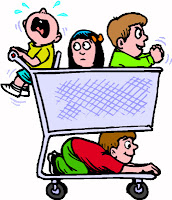Photo: Courtesy The Big Box of Art
This is Max Tell with my 5th instalment of writing exercises for professional and novice writers, those of you who are or would like to write poetry for kids. My apologies for not reaching my deadline last week. I will do better.
Note: When referring to poems, I am also including songs. When referring to songs, I am usually focusing on the unique elements or qualities of songwriting.
In my last instalment, I introduced you to the Basics of Writing Poetry: Rhythm, Rhyme, and Story. Today, I would like to focus more specifically on Rhythm. I won't be able to cover all that is important about Rhythm in one blog entry, so this will be an introduction as well. However, I will add a great deal more in subsequent blogs. As a matter of fact, most topics will be dealt with in small helpings, building slowly to a complete whole, so I will not mention this again.
RHYTHM: AN INTRODUCTION PART ONE
Have you listened to rain drip-dropping onto a roof or into a puddle? Have you listened to the clip-clop of a horse galloping, or a basketball being drib-dribbled?
Those sounds make up rhythm. In music, rhythm is the union of sound and silence as in hands clapping. In poetry, rhythm is the union of strong and soft sounds, stressed and unstressed syllables. Some stresses are longer than others, some are shorter.
Rhythm is like waves on the sea, the up and down, up and down of the surf. The repeated patterns of waves in poetry is what creates rhythm.
Read the following nursery rhyme out loud. It's always helpful to read out loud, you will will find it easier to hear the difference between stressed and unstressed syllables and therefore better understand the rhythm.
Jack and Jill Went Up the Hill
Jack and Jill went up the hill
To fetch a pail of water.
Read it out loud again, while clapping your hand on the stressed syllables. How do you think you did? Check out my version below, noting the bold faced letters.
Jack and Jill went up the hill
To fetch a pail of water.
Did you clap your hands on the stressed syllables as marked? Try it again.
Here is another example. Read Mary Had a Little Lamb out loud while clapping to the rhythm.
Mary had a little lamb,
Its fleece was white as snow.
And everywhere that Mary went,
The lamb was sure to go.
Here are a few more examples:
Mary, Mary Quite Contrary Mary Had a Pretty Bird
Donkey, Donkey, Old and Gray
Goosey, Goosey, Gander
For more nursery rhymes, go to Mama Lisa and follow the above instructions.
Now, it's your turn, write your own poem with the same rhythm as Jack and Jill.
www.maxtell.ca
Resources:
Rhythm & Meter: Advanced Study
Essential Children's Collection
Next topic: Poetry Scansion
What would you like to know more about? Rhythm? Rhyme? Anything of your choice? Do you have a question about poetry? Your comments would be greatly appreciated.
Bye for now and see you
soon.
Have a great writing day.
Max
Have a great writing day.
Max
PS: Like writing, but
love editing.




No comments:
Post a Comment